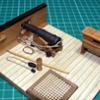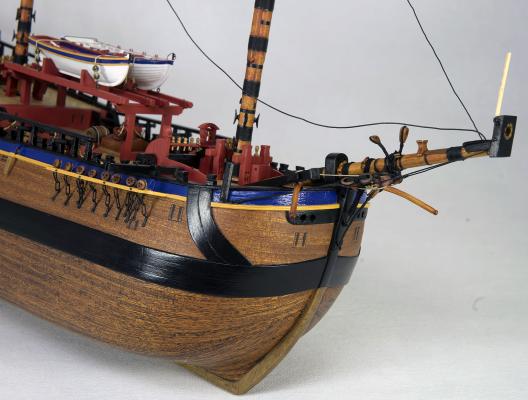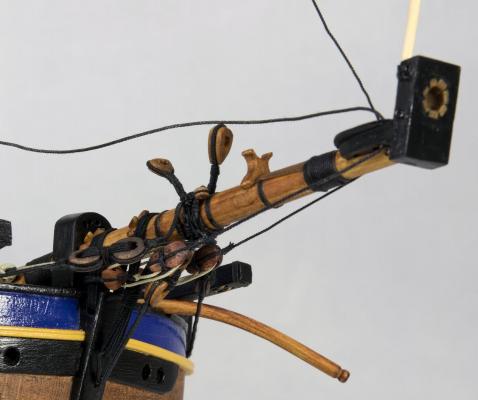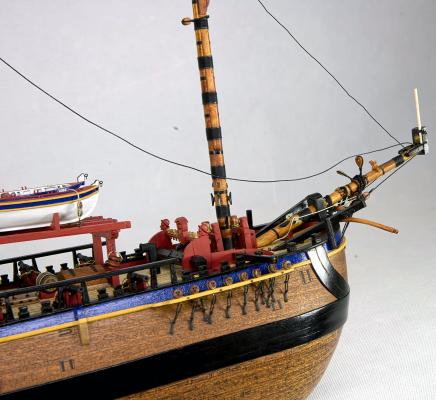-
Posts
5,928 -
Joined
-
Last visited
Content Type
Profiles
Forums
Gallery
Events
Everything posted by BANYAN
-
Hi Jay and BW; many thanks for the feed back. BW - I was almost at the same conclusion as you WRT to the ends where I see you settled on an eye. What period/year does your model represent please? Very nice seizing and serving of those pendants by the way. Jay, many thanks and that sort of confirms Parkins and Marquardt. I will have a look at an on-line copy of Falconer to see what he defines. I am currently using a single block to which the standing end of the tackle was fitted, with a single block at the running end, and which results in the falls being downward from the upper block to provide mechanical advantage. This is what Parkin shows, and both seem to think that for the mizzen burton pendant, the tackle was permanently rigged with the bottom block secured to an eyebolt on the mizzen channel, slightly inboard of and between the first and second shroud pairs. I now just need to determine where/how the falls were belayed My current leaning is towards a shroud cleat, or perhaps the closest belaying pin in the associated rail. Many thanks again, this is quite helpful.
-
Thanks Russ, I have decided to stay with Parkin as I know he researched fairly thoroughly and I am advised he and Karl had some great "debates' over some fittings etc such as the boomkins. I ma hoping that as they both agreed on this that they agreed their research on these I know they based most of their rigging on Steel anyway. cheers Pat
-
Well, well - I must say this surprises me - I thought there maybe someone out there who could help shed some light on the subject? In the end I looked at the drawings by Ray Parkin and his arrangement was very similar to that shown (in less detail) by Marquardt. I have decided to go with this even though according to Lees, this arrangement had been superceded by 1700. cheers Pat
-
Hi all, I am hoping that someone may be able to provide some definitive information to identify how the mizzen burton pendant would have been constructed in HM Bark Endeavour (1768). Hamilton raised this in his log at: http://modelshipworld.com/index.php?/topic/3575-lower-mast-tackles-burton-pendantstackles-top-ropes/?hl=%2Bburton+%2Bpendants I am comfortable with Lee's description but Marquardt shows these as rigged in his drawing but without sufficient detail to see the construction of the pendant and the associated tackle/falls. I see in other logs the advice is to not show the tackle as it would have been rigged as required; however, there is contradictory advice on how the sling end of the pendants are constructed/made up for this period. Anderson also states that up until the end of the 17th century the pendants were constructed with a single block in the hanging end (about level with the carpathans); however, by 1700 this was replaced with a violin block. I have not found any other reference that provides additional information but note quite a few modellers recommend/used a simple eye or eyering. Is there a reference evidence for this? It has also been suggested that as these pendants were used for several tasks (including the tensioning of the shrouds etc) that a single block with two part tackle (permanently in place) is valid to allow the required tackle type to be raised aloft forming a double(?) tackle arrangement - sounds a bit un-seaman-like though?). Some Club members have suggested that the violin block was replaced with two individual blocks (single over double) stropped together in the end of the pendant in a type of reverse violin arrangement? Can anybody please provide any definitive information as to the configuration of the Burton pendant ends/construction for around 1768/1770. cheers Pat
-

ancre LE BONHOMME RICHARD by Jeronimo - FINISHED
BANYAN replied to Jeronimo's topic in - Build logs for subjects built 1751 - 1800
That is so well detailed I am lost for words - excellent craftsmanship! How did you make the fine detail on the bolt heads? Are they individually filed/made? If so, you quality control and consistency is remarkable. cheers Pat- 662 replies
-
- bonhomme richard
- frigate
-
(and 1 more)
Tagged with:
-
Good to see the model itself last night Rod; and I agree with Keith, that is an excellent effort for a first build - very clean and smooth finish to her. I think she will build into a very nice model mate. cheers Pat
- 33 replies
-
- perseverance
- modellers shipyard
-
(and 1 more)
Tagged with:
-
Sorry to hear of the DF Ollie, get well soon we need you back in the shipyard! That's an unusual paint scheme for her. cheers Pat
- 803 replies
-
- colonial cutter
- modellers shipyard
-
(and 1 more)
Tagged with:
-
Great work and superb detaining Remco; these details take the build from great to extraordinary! Always a pleasure to see what new details you have added. Just one very minor query - is the tag just a little large for the sail? cheers Pat
- 1,214 replies
-
- sloop
- kingfisher
-
(and 1 more)
Tagged with:
-
Very very nicer work (as usual) Gary; she is looking great. Always a pleasure to look in on your builds. cheers Pat
-
Forget about the mumbling mate, the pictures spoke for themselves! An excellent job, the flickering light really enhances the model (which is looking great) - SWEET!!!!! cheers Pat
- 803 replies
-
- colonial cutter
- modellers shipyard
-
(and 1 more)
Tagged with:
-
Hi folks, I would have to agree with Zeh WRT the fog buoy; my experience has been with using the type he has shown (but my experience has been since 1970's). We also used these as 'splash targets' for small arm firings etc. Could the cruciform shape be a 'weight' for attaching to marker buoys such as a danbuoy or the like? We used to drop these as either drifting (unweighted) or static and would in my tme be weighted with a large concrete weight - this looks a little more elegant especially for releasing it? cheers Pat
-

cable laid vs rope (left vs right twist)
BANYAN replied to davec's topic in Masting, rigging and sails
Hi Jerry, actually it is the other way around -LH lay (S) lays up much stiffer and provides more strength and was generally used in standing rigging where strength was required (such as shrouds stays etc). However, it is not a hard and fast rule that LH lay rope was always used for shrouds etc; sometimes, shroud lay (4 strand) was used etc. RH lay being more flexible was generally used for running rigging. cheers Pat -

Thimble help needed
BANYAN replied to Senior ole salt's topic in Metal Work, Soldering and Metal Fittings
Hi S.o.s. - could you please advise exactly what part of the process is not working? If you find that the split tube sides are collapsing when bending, then you could try putting a bit of wire (same OD as the ID of the tube) into the channel as you bend it and that might help. If it is that you cannot obtain/bend a circle around the pliers perhaps a temporary jig using an old/broken drill bit of the appropriate OD, set into a wood offcut (secured to the bench or a vice), around which to form the ring might assist - similar to making wire rings. These two ideas can work together as a combination as I have used them successfully but I was using copper not aluminium. I hope this helps? Pat -
Hi Rod, thanks for looking in mate. I have brushed it on as I go; usually to the individual parts. I am contemplating a final all over spray as some recommend but I am still researching what long-term effects this may have on the rigging (worried it may go brittle with age). I will need to mask or avoid the finely detailed items and faux glass etc in the stern windows. I am also concerned that the white paint may yellow a bit with age with a coating of dull coat. cheers Pat
- 517 replies
-
- Endeavour
- Artesania Latina
-
(and 1 more)
Tagged with:
-
You may call it slow progress John, but this is positively flying compared to my build Look forward to seeing the update. cheers Pat
- 745 replies
-
- francis pritt
- mission ship
-
(and 1 more)
Tagged with:
-

ROYAL CAROLINE 1749 by Doris - 1:40 - CARD
BANYAN replied to DORIS's topic in - Build logs for subjects built 1501 - 1750
I'm just waiting for one of the figurines to come to life; they certainly look real enough! cheers Pat- 883 replies
-
- royal caroline
- ship of the line
-
(and 1 more)
Tagged with:
-
Looking the 'ants pants' mate! cheers Pat
- 803 replies
-
- colonial cutter
- modellers shipyard
-
(and 1 more)
Tagged with:
-
Mate for a first effort that is an absolutely terrific finish you have achieved. cheers Pat
- 33 replies
-
- perseverance
- modellers shipyard
-
(and 1 more)
Tagged with:
-
Thanks all for the positive feedback and likes; I very much appreciate you looking in. @russ - thanks mate; but you are being kind Take a look at the second photograph, the port side violin block strop has a raggedy finish to the 'fag-end' and the associated stay has some fuzz when you look at the full sized image (just to the top and left of the Bee. these were the last done and I had not checked them before fitting - but easily fixed. @jimlad - thanks John, have a little- quieter time (work and 'admiral's jobs') at the moment so I am able to spend a few more hours in the shipyard @greg lester - thanks Greg. It is a mixed bag, most of the scale rope is made by myself, but some of the running rigging is from MoRope. I can make LH laid rope quite well now (up to about 1.0 to 1.2mm dia.), but have not quite mastered RH. I use Jim Byrnes ropewalk and it is a particularly finicky (overly so) machine and you have to have everything 'just right' to get good quality rope. @mtaylor - thanks Mark, but you are being too nice . I can see some very poor workmanship on some of the very early work I did; but as this is my first serious wood ship I have been learning and improving as I go. I can definitely see some things which I just wish I had not accepted as 'acceptable' way back when cheers Pat
- 517 replies
-
- Endeavour
- Artesania Latina
-
(and 1 more)
Tagged with:
-
A very nicely done model Jan; a joy to look at. Your paint work is excellent with nice consistent colour and well defined edges etc. cheers Pat
-
Hi Ollie, I have poked my nose in once or twice to have a look at your build, but felt I needed to add a comment on your excellent planking and plating - your Mermaid looks nice. cheers Pat
- 803 replies
-
- colonial cutter
- modellers shipyard
-
(and 1 more)
Tagged with:
-
Hi folks, a small update having rebuilt the broken jib and doing some repairs. In the interim I have made the gaff, and started the standing rigging for the jib and mizzen mast. The close up photos have been sharpened to show the rope and rigging detail which has highlighted some rope fuzz and raggedy ends that needs repairs. Unfortunately this photo process also shows all the dents etc in the wood and exposed a few paint touch-ups that are required ( a good thing I suppose ) All comments and constructive criticism appreciated. cheers Pat
- 517 replies
-
- Endeavour
- Artesania Latina
-
(and 1 more)
Tagged with:
About us
Modelshipworld - Advancing Ship Modeling through Research
SSL Secured
Your security is important for us so this Website is SSL-Secured
NRG Mailing Address
Nautical Research Guild
237 South Lincoln Street
Westmont IL, 60559-1917
Model Ship World ® and the MSW logo are Registered Trademarks, and belong to the Nautical Research Guild (United States Patent and Trademark Office: No. 6,929,264 & No. 6,929,274, registered Dec. 20, 2022)
Helpful Links
About the NRG
If you enjoy building ship models that are historically accurate as well as beautiful, then The Nautical Research Guild (NRG) is just right for you.
The Guild is a non-profit educational organization whose mission is to “Advance Ship Modeling Through Research”. We provide support to our members in their efforts to raise the quality of their model ships.
The Nautical Research Guild has published our world-renowned quarterly magazine, The Nautical Research Journal, since 1955. The pages of the Journal are full of articles by accomplished ship modelers who show you how they create those exquisite details on their models, and by maritime historians who show you the correct details to build. The Journal is available in both print and digital editions. Go to the NRG web site (www.thenrg.org) to download a complimentary digital copy of the Journal. The NRG also publishes plan sets, books and compilations of back issues of the Journal and the former Ships in Scale and Model Ship Builder magazines.






